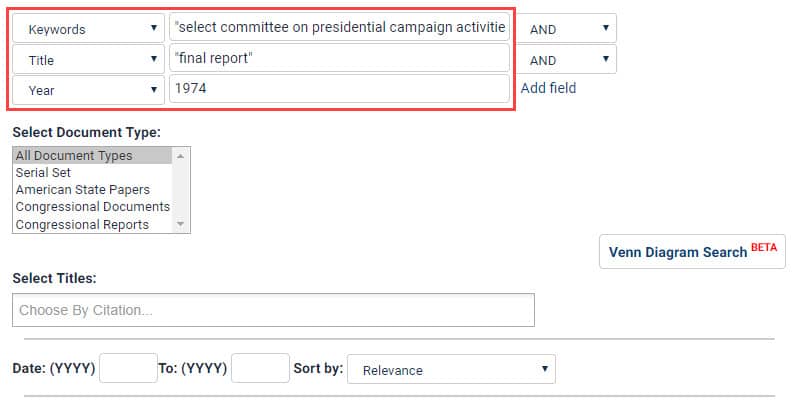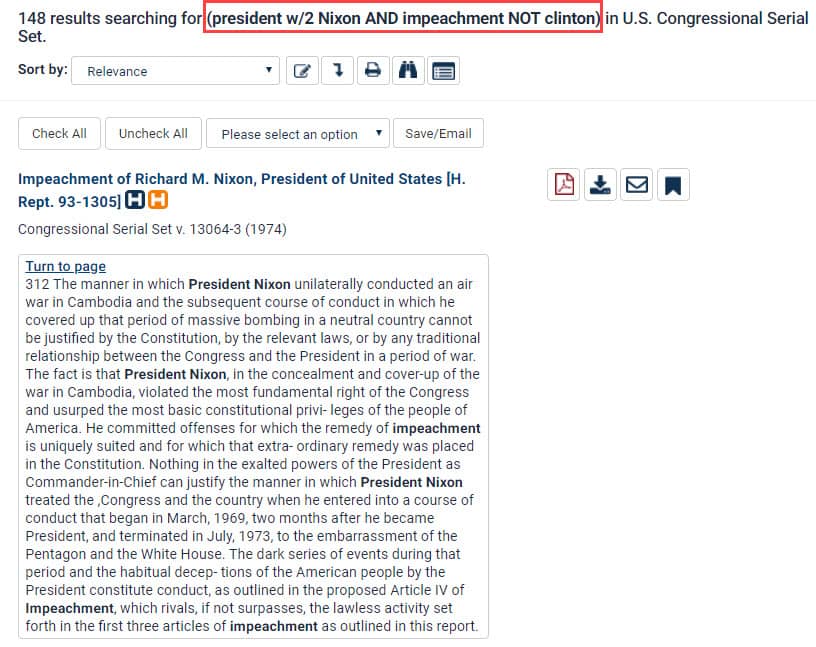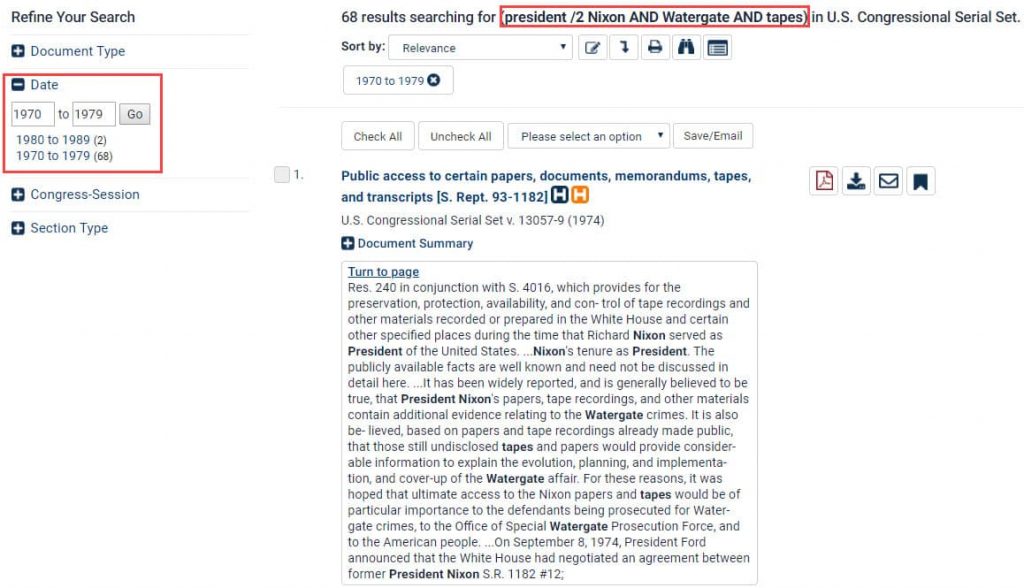In 2017, we published two posts about researching the Watergate scandal in HeinOnline. The first post demonstrated how to research the scandal using HeinOnline resources such as the Law Journal Library. The second focused on Watergate’s connection to the Pentagon Papers.
With the continued growth of HeinOnline’s U.S. Congressional Serial Set, even more material on Nixon and Watergate has become available. Catch up on the first two installments of this series, and then continue on to Part III: The U.S. Congressional Serial Set.
Quick Recap: Timeline of Watergate Events
- June 1972: Five men are arrested after breaking into the Democratic National Committee (DNC) headquarters at the Watergate complex in Washington, D.C. News stories in the following months claimed that the FBI was investigating the connection between the break-in and Nixon administration aides.
- November 1972: Nixon is elected to a second presidential term.
- January 1973: Two key government figures are found guilty of conspiracy and burglary, as well as of bugging the DNC headquarters.
- April 1973: Four Nixon aides resign due to the Watergate scandal.
- May 1973: An investigation is opened into the Watergate incident. During the Watergate hearings, it is revealed that Nixon had been secretly recording White House conversations since 1971. Despite judicial orders, Nixon refuses to hand over copies of the recordings.
- July 1974: Following a Supreme Court order, Nixon releases an edited version of the recordings. Expletives and inappropriate material are found to be censored, and an entire 18 minutes of one tape is found to be erased. Later in the same month, the House Judiciary Committee approves three articles of impeachment against Nixon.
- August 1974: The White House releases a tape from June 23, 1972—now known as the “smoking gun” tape—revealing that Nixon knew about the Watergate cover-up from the beginning. To avoid impeachment, Nixon resigns from the presidency.
Watergate in the Serial Set
Continuous additions to HeinOnline’s Serial Set have provided additional relevant information on the Watergate scandal. With the appropriate tailored searches, users can find congressional documents from each stage of the investigation and impeachment process.
The Investigation
In February of 1973, the United States Senate voted unanimously to approve Senate Resolution 60, establishing a committee which would initiate one of the most comprehensive investigations ever performed by Congress. Over a year and a half, the Select Committee on Presidential Campaign Activities surveyed the extent to which “illegal, improper, or unethical activities” occurred in Nixon’s 1972 Presidential campaign and election. As new revelations surfaced about the activities of Nixon’s administration—such as installing recording systems throughout the White House—President Nixon and his administration pushed back on the investigation, refusing at times to release essential tapes and transcripts. Ultimately, the findings of the Committee led to the indictment of forty government employees, the conviction of several Nixon administration officials, and the impeachment process against Nixon himself.
The Senate Watergate Committee published their findings in a seven-volume report on June 27, 1974. View the report in HeinOnline’s Serial Set by performing the advanced search below.

The Impeachment Process
In February of 1974, the House of Representatives gave the Judiciary Committee the authority to investigate the impeachment of Richard Nixon. View the House report initiating the impeachment process in the U.S. Congressional Serial Set.
In July of the same year, following the final report of the Senate Watergate Committee, the House Judiciary Committee voted 27 to 11 to recommend the first article of impeachment against Nixon: obstruction of justice. Two more articles were recommended over the next three days: abuse of power and contempt of Congress. In the face of certain impeachment, Nixon decided to resign on August 8, 1974.
View the final report, including the three articles of impeachment as well as supplemental, dissenting, minority, and other views in the Serial Set. Perform a full-text search for president w/2 Nixon AND impeachment NOT clinton to bring up the report as the first result.

Post-Resignation
Following Nixon’s resignation, Congress dropped all impeachment proceedings and Vice President Gerald Ford assumed the presidency. However, Nixon was still vulnerable to federal and state criminal prosecution. On September 8, 1974, Gerald Ford issued an unconditional pardon of Nixon, protecting the former president from prosecution for any crimes he may have committed during his terms in office.
After the Watergate scandal, Congress made efforts to provide public access to the papers, documents, tapes, transcripts, and other evidence relating to the Watergate investigation. Congress also passed the Presidential Recordings and Materials Preservation Act to prevent the destruction of Nixon’s presidential materials.
Read the views of Congress regarding the Watergate materials in the aftermath of the investigation with the Serial Set. Start by performing a full-text search for president /2 Nixon AND Watergate AND tapes. Limit the date range to “1970 to 1979.” The search will yield several related reports, including:
- Public access to certain papers, documents, memorandums, tapes, and transcripts
- Preserve, protect, etc., certain tape recordings
- Presidential recordings and materials preservation act
- Full public access to papers, documents, memorandum, tapes, and transcripts

To discover what else the Serial Set has to offer, check out our monthly blog series: Secrets of the Serial Set.
Like what you see? Brighten up your inbox with regular posts from the HeinOnline Blog. Click Subscribe in the upper right-hand corner of this post.



